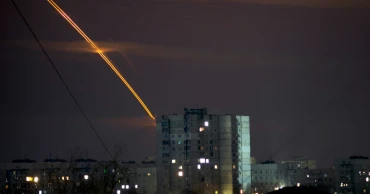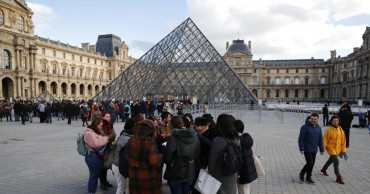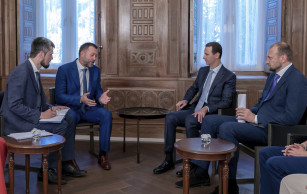Strikes
India alleges Pakistan targeted religious sites, homes in overnight strikes
India’s Defence Ministry has alleged that Pakistan attacked civilian infrastructure, including religious sites, during a series of overnight assaults under Operation Bunyan Marsoos.
“[Pakistan targeted] places of worship like the famous Shambhu Temple and residential areas in Jammu. Multiple armed drones have been sent through the night, endangering civilians and religious sites,” the ministry said in a statement.
Shelling kills senior official in Indian-administered Kashmir
It added, “The Indian Armed Forces remain vigilant and are committed to defending the sovereignty of the nation.”
7 months ago
Russian strikes in Ukraine kill 10 civilians, wound 20 more
Russian long-range strikes killed at least 10 civilians and wounded 20 others in several areas of Ukraine on Friday, Ukraine’s presidential office said, as a senior Moscow official warned that the Kremlin's forces were prepared for an expected Ukrainian counteroffensive in the coming weeks.
Five people died in Kostiantynivka, a town in eastern Ukraine's Donetsk province, when a Russian missile hit an aid station. Ukrainian authorities last year established hundreds of so-called “points of invincibility,” where residents hard-pressed by the war could warm up, charge their cellphones and get snacks.
Local prosecutors said the Russians attacked Kostyantynivka with S-300 anti-aircraft missiles. The civilians who died were refugees, according to Donetsk Gov. Pavlo Kyrylenko.
Also Read: Ukraine using Soviet-era helicopters to pummel Russia from afar
As the mostly artillery war of the recent winter months stretched into its second spring, Russian forces also used air-launched missiles, exploding drones and gliding bombs in their attacks on several regions early Friday, Ukrainian air force spokesman Yurii Ihnat said.
Two civilians were killed and nine were wounded in the Sumy province town of Bilopillia by a nighttime rocket and artillery barrage and air strikes, the administration of the northeast region said.
In the southern Kherson region, which Ukrainian President Volodymyr Zelenskyy visited Thursday, Russian shelling killed one person in the main city, also called Kherson, and killed another person and wounded four others in the town of Bilozerka.
On Wednesday, a Russian drone attack struck a high school and dormitories south of Kyiv, killing at least nine people.
Kyiv’s forces are poised to use the improved spring weather and the arrival of modern weapons supplied by its Western allies, including tanks, to launch a counteroffensive aimed at dislodging Russian troops from occupied areas of Ukraine.
But Dmitry Medvedev, Russia’s former president and now the deputy head of Russia’s Security Council chaired by President Vladimir Putin, said the Russian military was ready to repel a counterattack.
“Our General Staff is assessing all that,” Medvedev said.
He also said that a Ukrainian attempt to seize Crimea, which Russia annexed in 2014, could trigger a nuclear response from Moscow.
“An attempt to split part of the state away means an encroachment at the very existence of the state,” he said. “Quite obviously, it warrants the use of any weapons. I hope our ‘friends’ across the ocean realize that.”
Though known for his bombastic pronouncements, Medvedev’s warning stems from the Russian security doctrine envisaging the use of nuclear weapons in response to a nuclear attack or an attack with conventional weapons that threatens “the very existence of the Russian state.”
Medvedev also said that Western experts operating weapons, such as the U.S.-made Patriot air defense missile systems supplied to Ukraine, would be legitimate targets for the Russian military. Ukrainian soldiers have received training in the U.S., although Russian officials have frequently claimed that foreign instructors are present in Ukraine.
“If Patriot or other weapons are delivered to the territory of Ukraine along with foreign experts, they certainly make legitimate targets, which must be destroyed,” Medvedev told reporters in video clips he posted on his messaging app channel. “They are combatants, they are the enemies of our state and they must be destroyed.”
“They must understand that as soon as an American or a Polish soldier shows up there, he must be killed,” he added.
The Kremlin’s goal is to “create a sanitary cordon” of up to 100 kilometers (60 miles) around Russian-held areas so short- and mid-range weapons can't strike them, according to Medvedev.
Moscow may even set its sights on grabbing a bigger chunk of Ukrainian territory, stretching all the way to the border with Poland, he said.
2 years ago
Pockets of shelling across Ukraine as wintry warfare looms
Shelling by Russian forces struck several areas in eastern and southern Ukraine overnight as utility crews continued a scramble to restore power, water and heating following widespread strikes in recent weeks, officials said Sunday.
With persistent snowfall blanketing the capital, Kyiv, Sunday, analysts predicted that wintry weather — bringing with it frozen terrain and grueling fighting conditions — could have an increasing impact on the direction of the conflict that has raged since Russian forces invaded Ukraine more than nine months ago.
But for the moment, both sides were bogged down by heavy rain and muddy battlefield conditions in some areas, experts said.
After a blistering barrage of Russian artillery strikes on at least two occasions over the past two weeks, infrastructure teams in Ukraine were fanning out in around-the-clock deployments to restore key basic services as many Ukrainians dealt with only a few hours of electricity per day — if any.
Ukrenergo, the state power grid operator, said Sunday that electricity producers are now supplying about 80% of demand. That’s an improvement from Saturday’s 75%, the company says.
The Institute for the Study of War, a think tank that has been closely monitoring developments in Ukraine, said reporting from both sides indicated that heavy rain and mud have had an impact — but wider freezing expected along the front lines in coming days could play a role.
Read more: Most Ukrainians left without power after Russian strikes
“It is unclear if either side is actively planning or preparing to resume major offensive or counter-offensive operations at that time, but the meteorological factors that have been hindering such operations will begin lifting,” it said in a note published Saturday.
ISW said Russian forces were digging in further east of the city of Kherson, from which they were expelled by Ukrainian forces more than two weeks ago, and continued “routine artillery fire” across the Dnipro River.
In the eastern Donetsk region, five people were killed in shelling over the past day, according to governor Pavlo Kyrylenko. Overnight shelling was reported by regional leaders in the Zaporizhzhia and Dnipropetrovsk areas to the west.
Kharkiv governor Oleh Syniehubov said one person was killed and three wounded in the northeastern region.
A day earlier, a long column of cars, vans and trucks caravanned away from the recently liberated city of Kherson after intense shelling in recent days and amid concerns more pummeling from the Russian forces nearby could loom again in coming days.
Read more: Civilians escape Kherson after Russian strikes on freed city
“The day before yesterday, artillery hit our house. Four flats burned down. Windows shattered,” said city resident Vitaliy Nadochiy, driving out with a terrier on his lap and a Ukrainian flag dangling from a sun visor. “We can’t be there. There is no electricity, no water, heating. So we are leaving to go to my brother.”
3 years ago
Protect farmers from lightning strikes: JS Body
The relevant parliamentary standing committee on Wednesday recommended the government to take necessary steps to protect farmers from lightning strikes alongside raising public awareness in this regard.
It also asked the government to consider the allocation of cash money instead of rice to recover from the damages in the disaster-hit areas.
The Parliamentary Standing Committee on Disaster Management and Relief Ministry came up with the recommendations at its 29th meeting held in the Jatiya Sangsad (JS) Bhaban with its chairman AB Tajul Islam in the chair.
Read more: 12 killed in lightning strikes, a high for the year
The parliamentary watchdog suggested the ministry keep a reserve fund to face any emergency situation arising out of atural disasters.
Committee members Aftab Uddin Sarker, Mir Mushtaque Ahmed Robi, Jewel Areng and Masud Uddin Chowdhury attended the meeting.
The Disaster Management and Relief Secretary and the Director General of Disaster Management and Relief Directorate, among other high officials, were present at the meeting, said a Parliament release.
3 years ago
Turkish strikes in north Iraq kill 8 tourists, wound over 20
Turkish airstrikes killed eight tourists in northern Iraq and wounded over 20, Iraqi Kurdish officials said on Wednesday.
At least four missiles struck the resort area of Barakh in the Zakho district in the semi-autonomous Kurdish-run region, district mayor Mushir Mohammed told The Associated Press. All the casualties were Iraqi citizens.
Hundreds of Iraqi tourists come to the Kurdish region from the south during the peak summer months because the weather is relatively cooler. The touristic sites in Zakho is nearby military bases set up by Turkey.
Prime Minister Mustafa al-Kadhimi dispatched a delegation to the area lead by Foreign Minister Fuad Hussein.
Turkey regularly carries out airstrikes into northern Iraq and has sent commandos to support its offensives targeting elements of the outlawed Kurdistan Worker's Party or PKK.
Read: Iraqi soldiers kill nine IS militants
Wednesday's attack marked the first time that tourists had been killed in the frequent attacks by Turkey in the area, the officials said.
In April, Turkey launched its latest offensive, named Operation Claw Lock, in parts of northern Iraq - part of a series of cross-border operations started in 2019 to combat the outlawed PKK who are based in the mountainous regions of northern Iraq.
The PKK, which is listed as a terrorist organization by Turkey, the United States and the European Union, and has led an insurgency in southeast Turkey since 1984 which has killed tens of thousands of people.
Ankara has pressed Baghdad to root out PKK elements from the northern region. Iraq, in turn, has said Turkey's ongoing attacks are in breach of its sovereignty.
3 years ago
Islamic State strikes from shadows in vulnerable Syria, Iraq
With a spectacular jail break in Syria and a deadly attack on an army barracks in Iraq, the Islamic State group was back in the headlines the past week, a reminder of a war that formally ended three years ago but continues to be fought mostly away from view.
The attacks were some of the boldest since the extremist group lost its last sliver of territory in 2019 with the help of a U.S.-led international coalition, following a years-long war that left much of Iraq and Syria in ruins.
Residents in both countries say the recent high-profile IS operations only confirmed what they’ve known and feared for months: Economic collapse, lack of governance and growing ethnic tensions in the impoverished region are reversing counter-IS gains, allowing the group to threaten parts of its former so-called caliphate once again.
READ: General says US troops to remain in Iraq
One Syrian man said that over the past few years, militants repeatedly carried out attacks in his town of Shuheil, a former IS stronghold in eastern Syria’s Deir el-Zour province. They hit members of the Kurdish-led security force or the local administration — then vanished.“We would think it is over and they’re not coming back. Then suddenly, everything turns upside down again,” he said.
They are “everywhere,” he said, striking quickly and mostly in the dark, creating the aura of a stealth omnipresent force. He spoke on condition of anonymity out of fear for his safety.
IS lost its last patch of territory near Baghouz in eastern Syria in March 2019. Since that time, it largely went underground and waged a low-level insurgency, including roadside bombings, assassinations and hit-and-run attacks mostly targeting security forces. In eastern Syria, the militants carried out some 342 operations over the last year, many of them attacks on Kurdish-led forces, according to the Britain-based Syrian Observatory for Human Rights.
The Jan. 20 prison break in Syria’s Hassakeh region was its most sophisticated operation yet.
The militants stormed the prison aiming to break out thousands of comrades, some of whom simultaneously rioted inside. The attackers allowed some inmates to escape, took hostages, including child detainees, and battled the Kurdish-led Syrian Democratic Forces for a week. It was not clear how many militants managed to escape, and some remain holed up in the prison.
The fighting killed dozens and drew in the U.S.-led coalition, which carried out airstrikes and deployed American personnel in Bradley Fighting Vehicles to the scene. The battle also drove thousands of neighboring civilians from their homes.
It harkened back to a series of jail breaks that fueled IS’s surge more than eight years ago, when they overwhelmed territory in Iraq and Syria.
Hours after the prison attack began, IS gunmen in Iraq broke into a barracks in mountains north of Baghdad, killed a guard and shot dead 11 soldiers as they slept. It was part of a recent uptick in attacks that have stoked fears the group is also gaining momentum in Iraq.
READ: Tension rises in Iraq after failed bid to assassinate PM
An Iraqi intelligence source said IS does not have the same sources of financing as in the past and is incapable of holding ground. “They are working as a very decentralized organization,” said the official, who spoke on condition of anonymity to discuss security information.
The group’s biggest operations are conducted by 7-10 militants, said Iraqi military spokesman Maj. Gen. Yehia Rasool. He said he believes it is currently impossible for IS to take over a village, let alone a city. In the summer of 2014, Iraqi forces collapsed and retreated when the militants overran vast swathes of northern Iraq.
On its online channel, Aamaq, IS has been putting out videos from the prison attack and glorifying its other operations in an intensified propaganda campaign. The aim is to recruit new members and “reactivate quasi-dormant networks throughout the region,” according to an analysis by the Soufan Group security consultancy.
On both sides of the Syria-Iraq border, IS benefits from ethnic and sectarian resentments and from deteriorating economies. In Iraq, the rivalry between the Baghdad-based central government and the autonomous Kurdish region in the north of the country has opened up cracks through which IS has crept back. Sunni Arab disenchantment with Shiite politicians helps the group attract young men.
In Afghanistan, IS militants have stepped up attacks on the country’s new rulers, the Taliban, as well as religious and ethnic minorities.
In eastern Syria, the tensions are between the Kurdish-led administration and Arab population. IS feeds off Arab discontent with the Kurds’ domination of power and employment at a time when Syria’s currency is collapsing.
Kurdish authorities have carried out crackdowns against the Arab population on suspicion of IS sympathies, especially after a wave of protests against living conditions. At the same time, to reduce tensions, Kurdish authorities released detained Arabs and encouraged members of Arab tribes to join the ranks of the SDF. But those steps have raised concerns over infiltration or charges of corruption, adding to the challenges.
The militants have cells extending from Baghouz in the east to rural Manbij in Aleppo province to the west, according to Rami Abdurrahman, the head of the Syrian Observatory.
“They are trying to reaffirm their presence,” he said.
East Syria is also fractured among several competing forces. The Kurdish-led administration runs most of the territory east of the Euphrates, supported by hundreds of U.S. troops. The Syrian government, with its Russian and Iranian allies, is west of the river. Turkey and its allied Syria fighters, who view the Kurds as existential enemies, hold a belt along the countries’ border.
Dareen Khalifa, a senior Syria analyst for the International Crisis Group, said the SDF’s dependence on an “unpredictable U.S. presence” in fighting the militants is one of its biggest challenges.
She said the SDF is viewed as a lame duck that makes local residents reluctant to cooperate with anti-IS raids or provide intelligence on IS cells, particularly after the group threatened or killed many suspected collaborators in the past.
Moreover, the Kurdish authorities’ claim to be able to govern and provide services to the region and its mixed population “has taken a blow in 2021 as the economic conditions in the area deteriorated,” Khalifa said.
Residents say the Islamic State group is not collecting taxes or actively recruiting people, indicating they are not seeking to seize and control territory like they did in 2014, when they became de-facto rulers of an area that stretched across nearly a third of both Syria and Iraq. Instead, they exploit the security vacuum and lack of governance and resort to intimidation and kidnappings.
The resident of Shuheil in Deir el-Zour said they mostly operate at night, in flash attacks on military posts or targeted killings carried out from speeding motorcycles.
“It is always hit and run,” he said.
He described the area as constantly on edge, under an invisible threat from militants who blend into the population. The fear is so great, no one talks openly about them, whether good or bad, he said.
“Everyone is afraid of assassinations,” he said. “They have prestige, they have a reputation. They will never go away.”
3 years ago
Afghan killed by drone praised by co-workers in US aid group
The Afghan man who was killed in a U.S. drone strike last month was an enthusiastic and beloved longtime employee at an American humanitarian organization, his colleagues say, painting a stark contrast to the Pentagon’s claims that he was an Islamic State group militant about to carry out an attack on American troops.
Signs have been mounting that the U.S. military may have targeted the wrong man in the Aug. 29 strike in Kabul, with devastating consequences, killing seven children and two other adults from his family. The Pentagon says it is further investigating the strike, but it has no way to do so on the ground in Afghanistan after the Taliban takeover, severely limiting its ability to gather evidence.
Accounts from the family, documents from colleagues seen by The Associated Press, and the scene at the family home — where Zemerai Ahmadi’s car was struck by a Hellfire missile just as he pulled into the driveway — all seem to sharply contradict the accounts by the U.S. military. Instead, they paint the picture of a family that had worked for Americans and were trying to gain visas to the United States, fearing for their lives under the Taliban.
At the home, the mangled, incinerated Toyota Corolla remains in the driveway. But there are no signs of large secondary blasts the Pentagon said were caused by explosives hidden in the car trunk. In the tightly cramped, walled compound, the house is undamaged except for broken glass, even a badly built wooden balcony remains in place. A brick wall immediately adjacent to the car stands intact. Trees and foliage close to the car are not burned or torn.
Read: Trump aides aim to build GOP opposition to Afghan refugees
The family wants the United States to hear their side of the story and see the facts on the ground.
“We just want that they come here. See what they did. Talk to us. Give us the proof,” Emal Ahmadi, Zemerai’s younger brother, said of the U.S. military. Near tears, he opened a photo on his phone of his 3-year-old daughter, Malika, in her favorite dress. Another photo showed her charred remains after she was killed in the strike.
On Tuesday, U.S. Secretary of State Antony Blinken acknowledged he did not know if the man targeted in the strike was an IS operative or an aid worker. “I don’t know because we’re reviewing it,” he said at a Senate Foreign Relations Committee hearing.
The strike was carried out in the final days of the U.S. presence in Afghanistan, as American troops were carrying out evacuations at Kabul’s airport. Only days earlier, an IS suicide bombers at the airport killed 169 Afghans and 13 U.S. servicemembers.
The Pentagon says the strike prevented another IS attack at the airport. Officials said the U.S. military had been observing the car for hours as it drove and saw people loading explosives into the back. Days after amid reports of the children killed, Gen. Mark Milley, chairman of the Joint Chiefs of Staff, called it a “righteous strike,” and said “at least one of the people that were killed was an ISIS facilitator,” using an acronym for the Islamic State group.
The U.S. acknowledged reports of civilian casualties and said they may have been caused by secondary explosions. The family said when the 37-year-old Zemerai, alone in his car, pulled up to the house, he honked his horn. His 11-year-old son ran out, and Zemerai let the boy get in and drive the car into the driveway. The other kids ran out to watch, and the missile incinerated the car, killing seven children and an adult son and nephew of Zemerai.
“That was my last memory, the sound of his horn,” said another of Zemerai’s brothers, Romal Ahmadi, who was inside the house at the time. His three children, aged two to seven, were killed.
Zemerai worked for 15 years for Nutrition & Education International, a California-based non-profit aimed at countering malnutrition in Afghanistan. Romal also worked briefly for NEI.
Read: UN officials says rural Afghans have critical need for aid
Only days before the strike, Zemerai and Romal applied for special visas to the U.S. for those who had worked with U.S. companies. His brother, Emal and the nephew who was killed, Ahmad Naser Haideri, had also applied for special visas because of their work for the U.S. military.
Emal provided the AP with documents including their visa applications, letters of recommendation and even a medal Haideri had received for his service with a special U.S. trained elite special force. Haideri also had a letter of reference from the U.S.-based Multi Country Security Solutions Group, where he worked as a contractor, calling him “an important part of our commitment to provide the best faithful service to the U.S. Special Forces.”
“He was an excellent employee,” the firm’s president, Timothy Williams, who wrote the letter of reference, told the AP. “I’m not going to change from that just because of the incident that happened. I’m going to stand behind my guys.”
Zemerai’s colleagues at NEI described him as a talented worker who worked his way up from a handyman to a skilled engineer and an essential employee.
Last year, when the company was unable to pay employees at full salary because of the coronavirus pandemic, employees were given the opportunity to leave their positions for better paying work elsewhere.
But Ahmadi declined, saying, “I am NEI. From beginning to end, until we accomplish our goal,” the company’s founder and president, Steven Kwon, told the AP.
Colleagues recalled him as a doting father and enthusiastic dancer who kept an optimistic spirit amid the chaos of his surroundings and was quick to comfort those around him with a joke. He had grown up poor in Kabul and maintained “such a heart for the poor,” said a co-worker who asked to be identified only as Sonia for safety reasons.
“He was definitely the best of us. Absolutely,” she said.
He also always supported the company’s efforts to hire more women and create women’s programs, which is one of many reasons that colleagues said the suggestion that he was connected to any sort of extremism seems preposterous to them.
Read: AKDN urges international community not to abandon Afghanistan
“Everything we’re hearing about him is just so disturbing and so absurd because he had such love for his people,” said Sonia. “How would he overnight turn around and start wanting to kill his own people. It makes absolutely no sense at all whatsoever.”
It seems unlikely the U.S. will send anyone to the Ahmadi home to investigate. Pentagon spokesman John Kirby said he’s “not aware of any option that would put investigators on the ground in Kabul.” The U.S. Central Command said it would rely on “other means,” without elaborating but apparently meaning surveillance video and intercepts that led to the strike.
The family, grieving and furious, still wants refuge in the United States. On top of their already existing worries over their past work with the U.S., they now fear the new Taliban rulers will suspect them of being IS. The Islamic State group is a violent rival of the Taliban.
“The U.S. has accused us. They haven’t cleared our name and they won’t even talk to us, and now the suspicion is on us,” Emal said. “We are angry, but we don’t know what to do. For our safety we would go to America, but it must be all our families, not just me.”
Much to their dismay, Ahmadi’s colleagues say they haven’t been contacted by anyone from the Biden administration about what happened.
“Just talk to us because our teams are now terrified,” Sonia said. “I mean, in addition to being afraid of the Taliban and ISIS, they’re now even more afraid of the U.S. government.”
4 years ago
Paris Louvre museum closed amid strikes over pension plans
Paris' Louvre museum was closed Friday as dozens of protesters blocked the entrance to denounce the French government's plans to overhaul the pension system.
5 years ago
Syria activists: Strikes kill 3, including woman, her child
Beirut, Aug 26 (AP/UNB) — Syrian opposition activists say airstrikes targeting the country's last major rebel stronghold, the northwestern province of Idlib, have killed three civilians, including a woman and her child.
6 years ago





.jpg)








